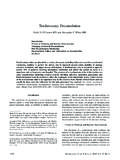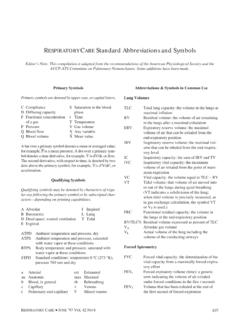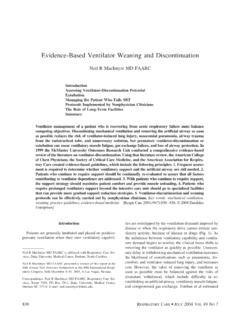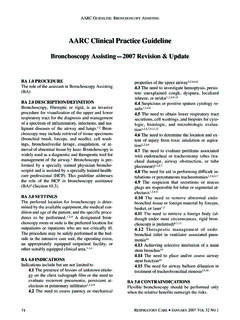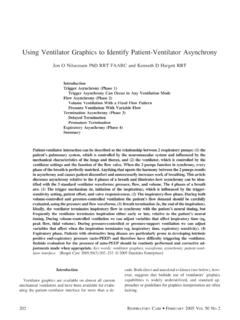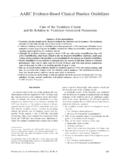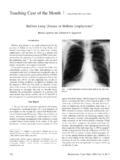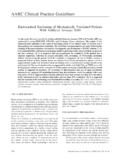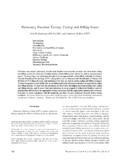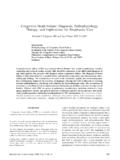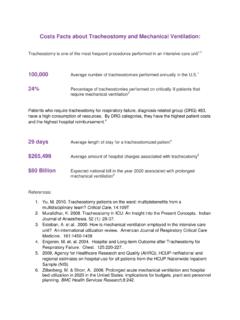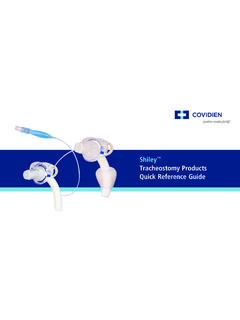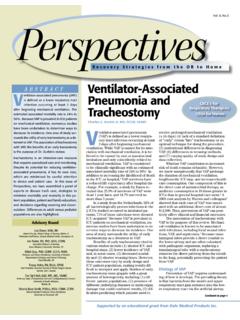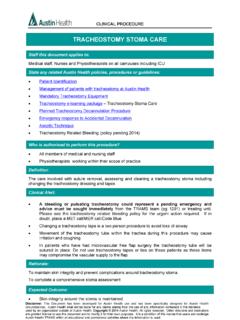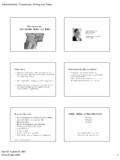Transcription of When to Change a Tracheostomy Tube - …
1 when to Change a Tracheostomy Tube Alexander C White MD, Sucharita Kher MD, and Heidi H O'Connor MD. Introduction The First Tracheostomy Tube Change Changing a Malpositioned Tracheostomy Tube Less Commonly Used Tracheostomy tubes Routine Tracheostomy Changes Summary Knowing when to Change a Tracheostomy tube is important for optimal management of all patients with Tracheostomy tubes . The first Tracheostomy tube Change , performed 1 2 weeks after place- ment, carries some risk and should be performed by a skilled operator in a safe environment. The risk associated with changing the Tracheostomy tube then usually diminishes over time as the tracheo-cutaneous tract matures. A malpositioned tube can be a source of patient distress and patient-ventilator asynchrony, and is important to recognize and correct.
2 Airway endoscopy can be helpful to ensure optimal positioning of a replacement Tracheostomy tube. Some of the specialized Tracheostomy tubes available on the market are discussed. There are few data available to guide the timing of routine Tracheostomy tube changes. Some guidelines are suggested. Key words: tracheos- tomy tube; Change ; malposition; routine. [Respir Care 2010;55(8):1069 1075. 2010 Daedalus Enter- prises]. Introduction ical ventilation,1,2 have upper-airway obstruction, have un- dergone a laryngectomy, or have difficulty managing The placement of a Tracheostomy tube secures the air- secretions and as a result are prone to recurrent aspiration way for patients who require prolonged invasive mechan- pneumonia.
3 The use of high-volume low-pressure cuffs, along with a tendency to place a Tracheostomy tube early in the course of mechanical ventilation, appears to have Alexander C White MD and Heidi H O'Connor MD are affiliated with improved outcomes in those patients receiving prolonged the Department of Pulmonary and Sleep Medicine, Rose Kalman Re- search Center, New England Sinai Hospital, Stoughton, Massachusetts. mechanical ,4 A Tracheostomy tube has advan- Sucharita Kher MD is affiliated with the Division of Pulmonary, Critical tages over an endotracheal tube, including a reduction in Care, and Sleep, Tufts Medical Center, Boston, Massachusetts. work of breathing, less laryngeal injury, and improved oral hygiene, and may allow for oral intake of Dr White presented a version of this paper at the 25th New Horizons Symposium, Airway Management: Current Practice and Future Direc- The proper management of a Tracheostomy tube is es- tions, at the 55th International Respiratory Congress of the American sential for patient comfort and communication.
4 There are Association for Respiratory Care, held December 5 8, 2009, in San a number of indications for changing a Tracheostomy tube Antonio, Texas. (Table 1), including the need for a size Change (either Dr White has disclosed a relationship with Breathe Technologies. The decreased as part of weaning from mechanical ventilation other authors have disclosed no conflicts of interest. and to facilitate vocalization and swallowing, or increased to allow passage of a bronchoscope into the airway); tube Correspondence: Alexander C White MD, Department of Pulmonary and Sleep Medicine, Rose Kalman Research Center, New England Sinai malfunction (eg, fractured flange or nonfunctional cuff);. Hospital, 150 York Street, Stoughton MA 02072.
5 E-mail: need for a different type of tube (eg, the need for a tube with an inner cannula); and routine changing as part of RESPIRATORY CARE AUGUST 2010 VOL 55 NO 8 1069. when TO Change A Tracheostomy TUBE. Table 1. Examples of Indications for Changing a Tracheostomy are usually placed to facilitate opening the stoma in the Tube event of accidental decannulation, and can be life-saving in the event of a decannulation occurring in an obese pa- First Change (7 14 days after placement). To reduce the size of the tube tient with increased neck circumference. All sutures are Routine Change (every 60 90 days) usually removed at the time of the first tube Change . Malpositioned tube due to incorrect length or size The process of changing a Tracheostomy tube is straight- Patient-ventilator asynchrony, Tracheostomy tube problem suspected forward in the majority of patients, but should be per- Cuff leak formed only by someone skilled in the procedure.
6 In gen- Tube or flange fracture eral, it is advisable to have 2 people present for any To allow passage of a bronchoscope (needs at least a mm inner Tracheostomy tube Change . Prior to removing the old tube, diameter) all components of the new Tracheostomy tube should be To Change the type of tube checked for integrity, an obturator should be available to help guide placement (usually present in the kit), and the cuff (in patients undergoing mechanical ventilation) in- ongoing airway management. This article will review the flated to check for leaks and then deflated prior to inser- timing of and indications for changing a Tracheostomy tion. One end of the securing tie may also be inserted tube. The information provided here is obtained from the through the slit in the flange on the outer cannula to fa- limited literature on the topic and also from expert opin- cilitate tying the tube after it is positioned.
7 The patient is ion. Areas covered include the first Tracheostomy Change , placed either supine or semi-recumbent, with the neck changing a malpositioned tube, some information on less extended and free of any clothing that could obstruct the commonly used Tracheostomy tubes , factors that can make stoma. The retaining sutures are removed, the tube gently it difficult to safely Change a Tracheostomy tube, and rou- withdrawn, the new Tracheostomy tube inserted, and the tine Tracheostomy tube Change . obturator removed. Removal of a tube through a tight stoma with a bulky cuff can be facilitated using 1 mL. The First Tracheostomy Tube Change of lidocaine jelly (1%) inserted around the stoma/tube interface. The first Tracheostomy tube Change is performed once The size and type of new tube inserted will depend on the tracheotomy tract has matured.
8 The indications for a the clinical circumstances. It is important to make sure the first Tracheostomy tube Change include downsizing the tube inner and outer diameters of the new Tracheostomy tube to improve patient comfort, to reduce pressure on the tra- are sized appropriately for the patient. The dimensions of cheal mucosa by reducing the tube external diameter, and Tracheostomy tubes (inner and outer diameter and length). to facilitate speech. In some patients the original trache- differ both with manufacturer and according to whether ostomy tube may have been the wrong size or length for the tube has an inner cannula, and these measurements the Conventional practice recommends changing must be taken into account when selecting a replacement the tube 7 14 days5 following placement; however, there tube.
9 The shape of the trachea has considerable normal are no data to support that time frame, which was sug- variability but is usually not a problem when selecting a gested to allow time for a stable endotracheal-cutaneous tube. The trachea does, however, have a smaller inner tract to form. Data from children suggest a much shorter diameter in adult females, compared with adult males. time to Change might be A survey of chief This is because the female trachea has attained its full size residents from otorhinolaryngology programs in the United by age 14 years, whereas the male trachea continues to States revealed a mean time interval between the trache- enlarge in diameter until growth is complete at age 17.
10 Ostomy placement and first tube Change of days (range 18 The male trachea attains an average cross- 3 7 d).8 The first tube Change in that study was performed sectional area of cm, and the female trachea in the intensive care unit, step-down unit, or on a regular cm. Therefore, in females a Tracheostomy tube A Tracheostomy tube is placed using either an open with an inner diameter of mm is usually adequate. surgical approach or the percutaneous approach, usually A slightly larger tube, with inner diameter mm, is under bronchoscopic guidance using a tapered adequate in males. If bronchoscopic airway evaluation is The percutaneous approach has been associated with fewer anticipated, a inner-diameter tube is required, and complications, such as wound infections; however, there sometimes even larger diameter tubes are needed, depend- can be a substantial learning curve for the ing on the diameter of the bronchoscope.
